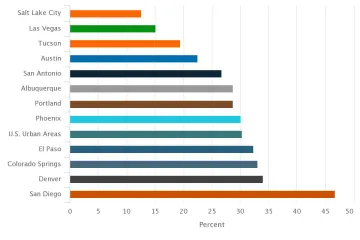Fewer Bumps Ahead: Tucson’s Roads Improve
Find out which Tucson roads have improved and by how much.

This talk explores driving patterns and road roughness in Tucson. Road conditions in Tucson have improved while many U.S. urban areas report deteriorating conditions. We discuss which roads in Tucson are improving, and how the region compares to the U.S. overall and other peer western urban areas.
The first MAP Dashboard “Pothole Index” rated Greater Tucson roads worst among peer urban areas in 2012. However, road conditions are now showing improvement, based on 2017 regional data and increased investments for pavement maintenance such as voter-approved bonds within the City of Tucson. While more improvement is needed, the percentage of other principal arterials reported in poor condition in the Tucson urban area has declined substantially over the past few years. This decline placed Tucson at the top among other peer urban areas in 2017, indicating an improvement for the area.
While some of the roads in Tucson have improved, that is not the case for much of the U.S., according to the 2018 Urban Roads Report. This report notes that “keeping the wheel steady on America’s roads and highways has become increasingly challenging as drivers encounter potholes and pavement deterioration.” They also point out that one-third of the nation’s major urban roadways are in poor condition.
Data reported in this article come from the International Roughness Index (IRI) which is the standard indicator of road roughness in the U.S. and elsewhere around the world. The data reflect conditions for several types of roadways. For the purpose of the “Fewer Bumps in the Road Ahead” article we focus our discussion primarily on other principal arterials but report data for four main types of roadways: interstates, other freeways and expressways, other principal arterials, and minor arterials. Other principal arterials are particularly important to the Tucson Urban Area because they account for a relatively large share of vehicle miles traveled in the region, nearly 36.0%.
Pavement quality plays a vital role in traffic flow and commuter comfort. When roads wear out, they must be rehabilitated and resurfaced to maintain smooth driving conditions since rough pavement decreases skid resistance, reducing motorist control under adverse driving conditions. Deteriorated roads also increase user costs, which over time can amount to a significant financial burden on the traveling public. The 2018 Urban Roads Report also found that the average motorist in the U.S. is paying $599 annually, a total of $130 billion nationally, in additional vehicle operating costs as a result of driving on roads in need of repair. Proper maintenance lengthens the useful life of a roadway, maximizes traffic operations and overall flow, and minimizes repair costs for road users.
Tucson’s improvement in road roughness of other principal arterials rated poor ranked it third in 2017 among comparable urban areas in the West (figure 1). Only 19.5% of other principal arterials in the Tucson Urban Area were in poor condition, while San Diego reported that nearly half of their other principal arterials were in poor condition. Salt Lake City, Las Vegas, and Tucson were the only urban areas to post rates under 20%.
Figure 1: Percent of Other Principal Arterials Rated Poor (2017)

To learn more about how Tucson and Southern Arizona are doing compared to peer western metros and regions in terms of economy, education, health and social well-being, infrastructure, quality of life, and much more, visit the Making Action Possible for Southern Arizona Dashboard. The MAP Dashboard project is produced by Eller's Economic and Business Research Center.

